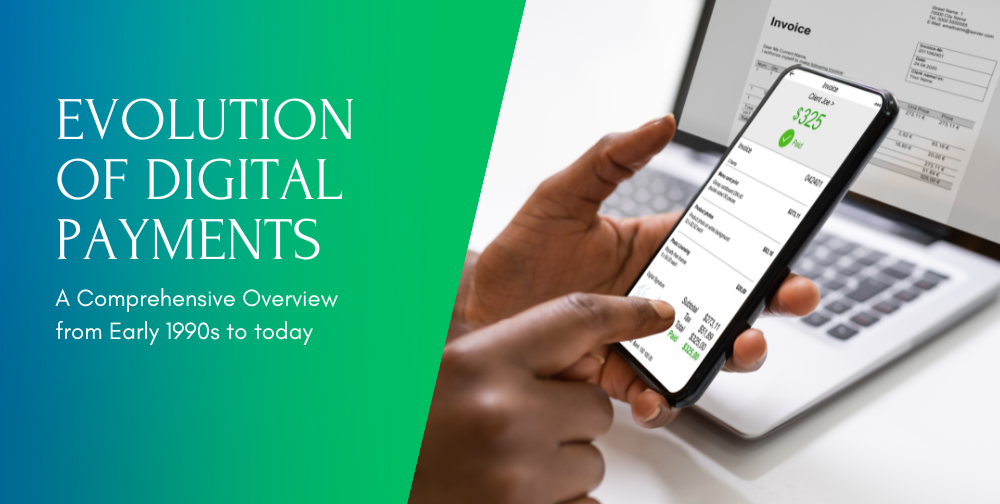The Evolution of Digital Payments: A Comprehensive Overview

Digital payments have undergone a remarkable transformation since their inception, becoming an indispensable component of modern economic systems. This evolution has been driven by technological advancements, changing consumer preferences, and the relentless pursuit of convenience and security. This article provides a detailed exploration of the evolution of digital payments, tracing their journey from the early days of online commerce to the sophisticated and diverse methods available today.
Early Beginnings: The 1990s
The foundation for digital payments was laid in the 1990s with the advent of the internet and the burgeoning field of online commerce. The initial forays into digital payments were rudimentary but ground-breaking. One of the earliest digital payment systems was developed by Stanford Federal Credit Union in 1994, which allowed customers to access banking functions online. This period also saw the birth of e-commerce giants like Amazon (founded in 1994) and eBay (founded in 1995), which necessitated the development of secure online payment systems.
Key Milestones:
First Secure Electronic Transaction (SET): In 1996, SET, a protocol for securing online credit card transactions, was introduced by Visa and MasterCard.
PayPal: Founded in 1998, PayPal revolutionized online payments by offering a simple, secure way for individuals and businesses to transfer money electronically.
The Rise of Mobile Payments: Early 2000s
The early 2000s marked the rise of mobile payments, driven by the proliferation of mobile phones and the advent of smartphones. This era saw the emergence of mobile banking and payment solutions that allowed users to conduct transactions on the go.
Key Developments:
SMS Payments: Early mobile payment systems relied on SMS technology. Customers could make payments by sending a text message, which was then billed to their mobile phone account.
WAP Payments: Wireless Application Protocol (WAP) enabled more sophisticated mobile transactions through mobile browsers.
Digital Wallets: Revolutionizing Peer-to-Peer Transactions
Digital wallets emerged as a game-changer in the mid-2000s, providing a seamless and secure way to store payment information and conduct transactions. These wallets enabled peer-to-peer (P2P) transactions, online purchases, and even in-store payments.
Notable Digital Wallets:
PayPal: As one of the pioneers, PayPal expanded its services to include mobile payments and P2P transfers.
Google Wallet: Launched in 2011, Google Wallet allowed users to store credit and debit card information and make payments using their mobile devices.
Venmo: Founded in 2009, Venmo became particularly popular among younger users for its social media-like interface that made splitting bills and sharing payments easy and fun.
Contactless Payments and NFC Technology
The adoption of near-field communication (NFC) technology in the late 2000s and early 2010s brought about the widespread use of contactless payments. This method allows users to make payments by simply tapping their NFC-enabled device (such as a smartphone or contactless card) on a compatible terminal.
Key Innovations:
Apple Pay: Introduced in 2014, Apple Pay utilized NFC technology to enable secure, contactless payments with iPhones and Apple Watches.
Samsung Pay and Google Pay: Both launched shortly after Apple Pay, offering similar contactless payment functionalities.
Diverse Digital Payment Methods: QR Codes, Biometrics, and Cryptocurrencies
The evolution of digital payments continued with the introduction of various innovative methods designed to enhance convenience, security, and accessibility.
QR Code Payments: QR code payments became popular, especially in Asia, due to their simplicity and low cost. Users can scan a QR code displayed by a merchant to complete a transaction.
Biometric Authentication: The integration of biometric authentication, such as fingerprint and facial recognition, added an extra layer of security to digital payments. This technology is widely used in mobile wallets and banking apps.
Cryptocurrencies: The emergence of cryptocurrencies, spearheaded by Bitcoin in 2009, introduced a decentralized form of digital payment. Cryptocurrencies offer a new paradigm for secure, borderless transactions, though their volatility and regulatory challenges remain significant hurdles.

Influential Events Shaping Digital Payments
Several notable events and trends have significantly influenced the evolution of digital payments:
E-Commerce Giants: The rise of e-commerce platforms like Amazon and Alibaba has driven the need for robust digital payment systems. These companies have also developed their own payment solutions (e.g., Amazon Pay, Alipay) to streamline transactions.
Fintech Startups: The proliferation of fintech startups has spurred innovation in digital payments. Companies like Square, Stripe, and Revolut have introduced new payment models, catering to both consumers and businesses with advanced features and user-friendly interfaces.
COVID-19 Pandemic: The COVID-19 pandemic accelerated the adoption of digital payments as consumers and businesses sought contactless alternatives to reduce physical contact and curb the spread of the virus. This period saw a significant increase in the use of contactless cards, mobile wallets, and online payment platforms.
Impact on Financial Inclusion
Digital payments have played a crucial role in enhancing financial inclusion, providing access to banking services for underserved populations. Mobile money services, such as M-Pesa in Kenya, have demonstrated the transformative power of digital payments in emerging markets, enabling millions of people to participate in the formal economy.
Future Trends and Innovations
As technology continues to advance, the future of digital payments looks promising, with several emerging trends poised to shape the landscape:
Blockchain and Decentralized Finance (DeFi): Blockchain technology underpins cryptocurrencies and offers potential for secure, transparent, and efficient payment systems. DeFi applications aim to replicate traditional financial services using blockchain, potentially revolutionizing the industry.
Artificial Intelligence (AI) and Machine Learning: AI and machine learning are being leveraged to enhance fraud detection, personalize user experiences, and streamline payment processes.
Internet of Things (IoT): The integration of IoT devices with payment systems can enable seamless transactions in smart environments, such as connected cars making automatic toll payments.
Central Bank Digital Currencies (CBDCs): Governments and central banks are exploring the issuance of digital versions of national currencies, known as CBDCs. These digital currencies aim to combine the benefits of digital payments with the stability of traditional fiat currencies.
Conclusion
The evolution of digital payments is a testament to the transformative power of technology in reshaping economic systems and consumer behaviors. From the early days of online commerce to the sophisticated and diverse payment methods available today, digital payments have come a long way. The journey has been marked by continuous innovation, driven by the need for convenience, security, and financial inclusion.
As we look to the future, the landscape of digital payments will undoubtedly continue to evolve, influenced by emerging technologies and changing consumer expectations. The convergence of blockchain, AI, IoT, and other cutting-edge technologies promises to bring about even more innovative and secure forms of digital payments, further integrating them into the fabric of our daily lives.
The story of digital payments is one of relentless progress and adaptation, reflecting the dynamic nature of technology and its profound impact on the way we live, work, and transact.




